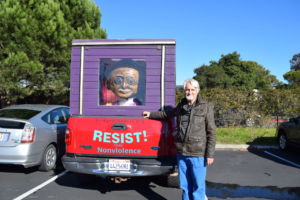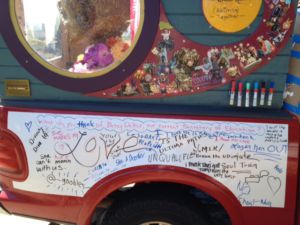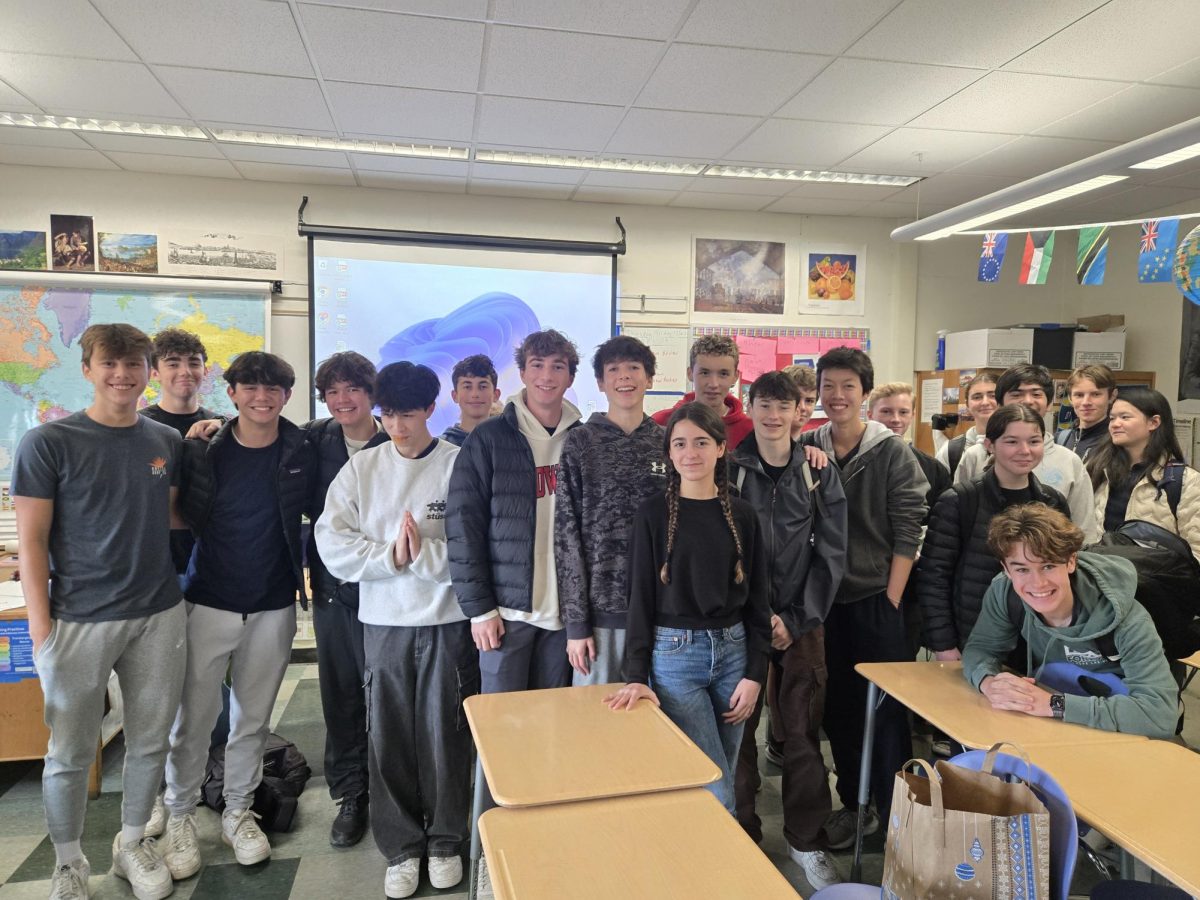Perhaps you’ve seen a red Ford truck mounted with a massive Mahatma Gandhi head driving out of the parking lot after school. Maybe you recognize the bright yellow smiling suns drawn on the whiteboards of classrooms with the name “Mr. Richardson” scrawled underneath. Whether you know him or not, chances are you’ve seen or heard of one of Jes Richardson’s distinct trademark symbols, which are not just for show. While most Redwood students may know him as a cheerful substitute teacher, many across the world know him as a tireless peace activist.
Richardson said he has been involved in activism for almost his entire adult life, creating his own organization called Bridge of Hearts ten years ago, and has traveled worldwide to promote his cause of peace. He visited Iran in 2007, when it seemed to him that the United States was going to go to war, and again in 2010 to see for himself if the Iranian people were as harsh as they were portrayed in the U.S. media. When he returned from Iran, he talked with legislators in Washington, D.C. to try to persuade them not to increase sanctions on Iran but instead work with the country.

“One occasion, Hillary Clinton had just made a statement about obliterating Iran, and I made a banner that said ‘Obliterate? Apologize!’ I was able to get into a fundraiser with her and I also got within about 10 feet of Hillary, and I jumped up on this table and pulled out my banner and caught her by surprise,” Richardson said.
Although Richardson said that Clinton didn’t make any response to his action, he believes he made some sort of an impact upon her in that moment. In the hopes of persuading legislators toward peace, Richardson created the Gandhi head out of a beach ball and paper mache 15 years ago. His purpose was both to support the Mill Valley Seniors for Peace, who demonstrate weekly, and to showcase a groundbreaking figure to promote the spread of peace. Since then, it has been spotted across the country, traveling all the way to Philadelphia to support Bernie Sanders before the 2016 election.
Before the puppet had even found its home in the red truck, Richardson was awarded the Marin Human Rights Commission Martin Luther King Jr. award for Community Service in 2015, which he believes is due to his activism and outspokenness on issues in Washington, D.C. More than anything, the Gandhi puppet has become a widely recognized symbol throughout Marin County, decked out with messages including Richardsons motto, ‘RESIST! Thru Nonviolence.’
“I was looking for an easier way to transport the Gandhi puppet, [which] low and behold, has resulted in [me] having been awarded the Martin Luther King award. Indirectly, the Ford F-150 truck came my way. It used to belong to the fire chief in Woodacre. I took the opportunity to turn it into the Gandhi-mobile and to drive around and encourage people to resist through nonviolence,” Richardson said.
The Gandhi-mobile serves as both a public educator and a discussion starter. According to Richardson, he and his partner of six years, Mara Chitayat, write questions on the whiteboard attached to the side of the truck, leave out markers and wait for people to respond—most recently, ‘What does your heart feel about the attacks on women right now?’
“It’s really a lot of fun to watch, in particular, a mother or father explaining to their children who Gandhi was, and also writing on the whiteboard is a nice way to interact with the public,” Richardson said. “I particularly like sitting in a cafe and parking the Gandhi-mobile in front of the cafe and watching people give input on the whiteboard.”
Besides being seen parked in local vicinities and at the Democratic National Convention in Pennsylvania, the Gandhi mobile has traveled up and down the hills of San Francisco supporting a female-founded organization for peace. Toby Blomé, an activist and member of Code Pink since 2003, became acquainted with Richardson through his participation in the organization, including at a San Francisco George Bush impeachment march in 2007. The march went for about three miles, from Ocean Beach to Congresswoman Nancy Pelosi’s house.
“We brought that puppet, which was on a wheeled platform, and we pushed it all the way up into the hills of Pacific Heights, a hilly area, all the way from Ocean Beach. So Gandhi has been to ‘Camp Pelosi’ more than once for supporting our effort in trying to influence Congress to not let the wars continue,” Blomé said.
Chitayat has been involved in many of Richardson’s activism endeavors, including helping create the Gandhi-mobile and working on a small film called “The Beautiful People of Iran,” which Richardson produced for his Bridge of Hearts website. Chitayat believes that the vehicle serves as a conversation starter for people to learn more about spreading peace and activism.
“The way I see it is that people need to have their voices heard. And some people have a lot of passion and feelings about what’s going on in the world right now,” Chitayat said. “I think it’s great to have something that’s both playful and wise that gives people a place to write what they feel and think and share it with other people that probably have similar values.”
Chitayat also believes that while it’s notable to start grassroots movements in local communities in order to create change on a small scale, it’s not always the most effective course of action to take. Especially because Marin is already so liberal, she believes the Gandhi symbol could wield even more influence elsewhere in the country.

“I think it would be far more powerful if the Gandhi-mobile was in a red state. I think that there are people that are very neglected in this country and are being exposed to really distorted news and things like that, and they don’t understand the mechanisms, and really they’re not very interested in it,” Chitayat said.
Not only is the truck a political force, but its eye catching appearance serves as an unconventional yet effective way to influence people who may be curious.
“I think one thing that’s great about the Gandhi-mobile is that it’s entertaining, and it’s really not just political, it’s also about the spirit. And it tells people that they can be good people, and they can be kind, and they can make a different system,” Chitayat said.
Since 2009, Blomé has been focusing her activism on ending the use of drone warfare in Middle Eastern countries. Believing in the same motto as Richardson, peace through nonviolence, Blomé spreads her message by trying to model peace in her words and actions.
“For me, what’s important is that no matter what I choose to do, that I try to always be careful to model peace. Not just in my physical actions, but in my temperament and the words I choose to use,” Blomé said. “I have to confess because I’m human, and I feel a lot of passion on this issue, that I do catch myself sometimes [getting really upset] for example if a police officer [might try to] take my free speech rights away.”
Both Richardson and Chitayat said that involving and educating the younger generations on peace and activism is crucial to changing the current system of society. Chitayat thinks that although it’s up to lawmakers and not regular individuals to start or end wars, every person can contribute to changing the public mindset through spreading more care and hope.
“I really feel that what we can do is be better people. We cannot fall for the lies and we can make our own worlds, and make them better,” Chitayat said. “Young people are particularly good at that and they can really do that when they work and they start doing things a certain way. Before their spirits are killed or anything, they can still have some idealism and carry it forward and make a difference.”
Blomé echoes that it’s important to educate the public on the issues of violence and human rights violations that they might not know are happening, especially on crimes committed by the United States government. However, while activism is so important, it can wear down on the individuals who try to promote peace by spreading news of such atrocities.
“The hard things is one person can only do so much because then there’s your own life, trying to find balance because you can’t give 100 percent of yourself to this, because you will run out of juice. You have to have time for restoration and doing the things that bring you joy,” Blomé said. “Activism does bring me joy on a certain level but it’s also very a serious topic around war and peace.”
According to Richardson, one main reason he got involved with substitute teaching was to inspire and educate younger generations on the issues he’s passionate about, such as peace through nonviolence. If he were to give any advice to younger generations on how to spread the message effectively, he says he would tell them to get involved early.
“Get involved at a grassroots level that you really can make a difference out there, join a group, find something that inspires you and have fun doing it. Get to know people. We’re creating a new world. Be involved in the process. It’s wildly exciting,” Richardson said.





